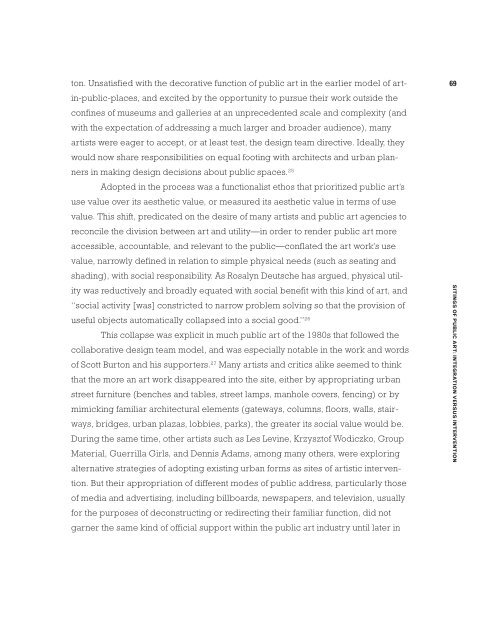ONE PLACE AFTER ANOTHER - Monoskop
ONE PLACE AFTER ANOTHER - Monoskop
ONE PLACE AFTER ANOTHER - Monoskop
You also want an ePaper? Increase the reach of your titles
YUMPU automatically turns print PDFs into web optimized ePapers that Google loves.
ton. Unsatisfied with the decorative function of public art in the earlier model of artin-public-places,<br />
and excited by the opportunity to pursue their work outside the<br />
confines of museums and galleries at an unprecedented scale and complexity (and<br />
with the expectation of addressing a much larger and broader audience), many<br />
artists were eager to accept, or at least test, the design team directive. Ideally, they<br />
would now share responsibilities on equal footing with architects and urban planners<br />
in making design decisions about public spaces. 25<br />
Adopted in the process was a functionalist ethos that prioritized public art’s<br />
use value over its aesthetic value, or measured its aesthetic value in terms of use<br />
value. This shift, predicated on the desire of many artists and public art agencies to<br />
reconcile the division between art and utility—in order to render public art more<br />
accessible, accountable, and relevant to the public—conflated the art work’s use<br />
value, narrowly defined in relation to simple physical needs (such as seating and<br />
shading), with social responsibility. As Rosalyn Deutsche has argued, physical utility<br />
was reductively and broadly equated with social benefit with this kind of art, and<br />
“social activity [was] constricted to narrow problem solving so that the provision of<br />
useful objects automatically collapsed into a social good.” 26<br />
This collapse was explicit in much public art of the 1980s that followed the<br />
collaborative design team model, and was especially notable in the work and words<br />
of Scott Burton and his supporters. 27 Many artists and critics alike seemed to think<br />
that the more an art work disappeared into the site, either by appropriating urban<br />
street furniture (benches and tables, street lamps, manhole covers, fencing) or by<br />
mimicking familiar architectural elements (gateways, columns, floors, walls, stairways,<br />
bridges, urban plazas, lobbies, parks), the greater its social value would be.<br />
During the same time, other artists such as Les Levine, Krzysztof Wodiczko, Group<br />
Material, Guerrilla Girls, and Dennis Adams, among many others, were exploring<br />
alternative strategies of adopting existing urban forms as sites of artistic intervention.<br />
But their appropriation of different modes of public address, particularly those<br />
of media and advertising, including billboards, newspapers, and television, usually<br />
for the purposes of deconstructing or redirecting their familiar function, did not<br />
garner the same kind of official support within the public art industry until later in<br />
69<br />
SITINGS OF PUBLIC ART: INTEGRATION VERSUS INTERVENTION

















